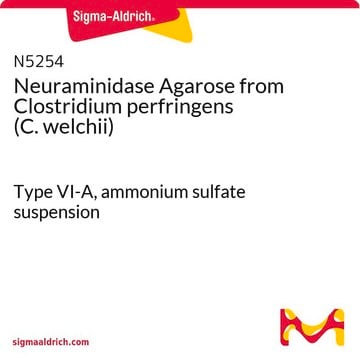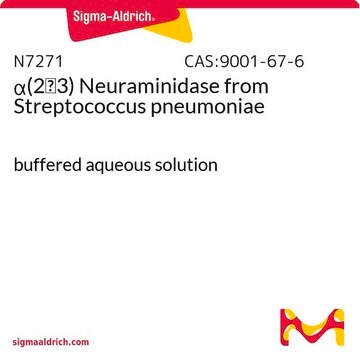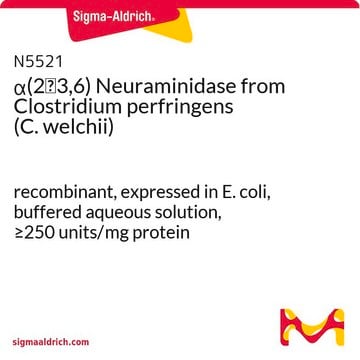The kit has been verified for use with bacterial cultures. Although there isn't a tailored sample preparation protocol for bacterial cultures, the following general cell lysate preparation method is suggested:
To prepare cell samples, first, suspend approximately two million harvested cells (2 × 10^6) in 400 μL of PBS on ice. Cell lysis can be accomplished by either using a Dounce homogenizer for 10-20 passes while on ice or through sonication in an ice-water bath. The effectiveness of lysis should be verified under a microscope. After lysis, centrifuge the homogenate at 14,000 g for 10 minutes and then transfer the clear supernatant to a clean tube. It is recommended to run a pilot assay with different sample dilutions to identify a dilution that falls within the linear range of the standard curve for accurate assays. If immediate analysis is not possible, most samples can be preserved at -80°C.
MAK121
Neuraminidase Activity Assay Kit
sufficient for 100 colorimetric or fluorometric tests
Synonym(s):
Sialidase Activity Assay Kit
About This Item
Recommended Products
usage
sufficient for 100 colorimetric or fluorometric tests
application(s)
pharmaceutical
detection method
colorimetric
fluorometric
shipped in
dry ice
storage temp.
−20°C
General description
Application
- 5-Nitrobenzo[c][1, 2, 5]selenadiazole as therapeutic agents in the regulation of oxidative stress and inflammation induced by influenza A(H1N1)pdm09 in vitro and in vivo.: This research utilized the Neuraminidase Activity Assay Kit to explore therapeutic agents that regulate oxidative stress and inflammation, showcasing its crucial role in antiviral research and potential pharmacological applications (Guo et al., 2023).
- Potency of bacterial sialidase Clostridium perfringens as antiviral of Newcastle disease infections using embryonated chicken egg in ovo model.: Highlights the kit′s use to measure and observe sialidase enzyme activity to assess the antiviral potential of bacterial enzymes against poultry diseases, contributing to the development of novel biocontrol methods (Kurnia et al., 2022).
- Molecular Docking Studies and Biological Evaluation of Berberine-Benzothiazole Derivatives as an Anti-Influenza Agent via Blocking of Neuraminidase.: Utilizes neuraminidase assay kit to evaluate the efficacy of synthesized compound′s neuraminidase activity, offering a path towards the design of new antiviral drugs with enhanced specificity and potency (Kumar et al., 2021).
Features and Benefits
Suitability
Principle
Signal Word
Danger
Hazard Statements
Precautionary Statements
Hazard Classifications
Resp. Sens. 1 - Skin Sens. 1
Storage Class Code
10 - Combustible liquids
Choose from one of the most recent versions:
Certificates of Analysis (COA)
Don't see the Right Version?
If you require a particular version, you can look up a specific certificate by the Lot or Batch number.
Already Own This Product?
Find documentation for the products that you have recently purchased in the Document Library.
Customers Also Viewed
-
Is it possible to use the Neuraminidase Activity Assay Kit (MAK121-1KT) for testing bacterial cultures, given that references indicate the use of plasma, serum, and purified enzymes as samples?
1 answer-
Helpful?
-
-
What type of sialic acid linkage is present in this kit? Specifically, is it an α2,3- or α2,6-linkage?
1 answer-
The substrate utilized is fetuin, which is a heavily sialylated protein derived from fetal bovine serum. The specific type of sialic acid linkage present in this substrate has not been characterized. However, fetuin typically exhibits two types of linkages: α2,3- and α2,6-linkages. It is more common for α2,3-linkages to be present in fetuin substrates, which suggests that experiments targeting this linkage type are likely to be successful. Nonetheless, it is not possible to provide a definitive statement on the exact type of linkage present.
Helpful?
-
-
Hallo, welches MQ Level hat das Material MAK121?
1 answer-
These kits is considered an out of scope in terms of the MQ Classification system, but are handled and supported similarly to the MQ100 level products.
Helpful?
-
Active Filters
Our team of scientists has experience in all areas of research including Life Science, Material Science, Chemical Synthesis, Chromatography, Analytical and many others.
Contact Technical Service










